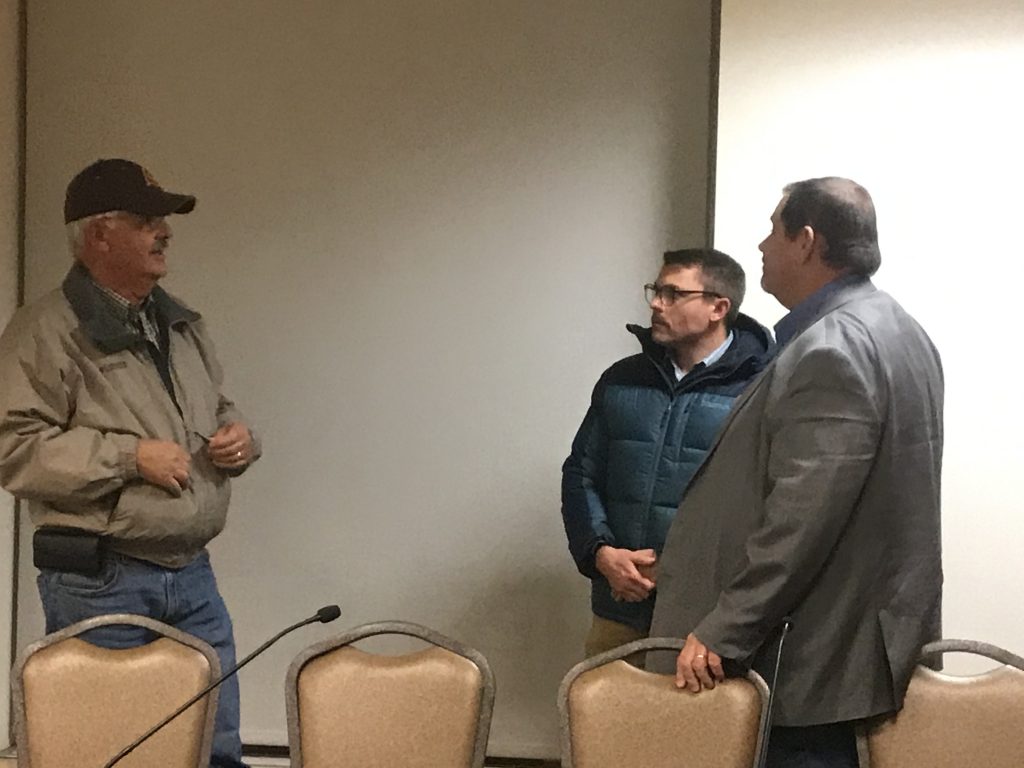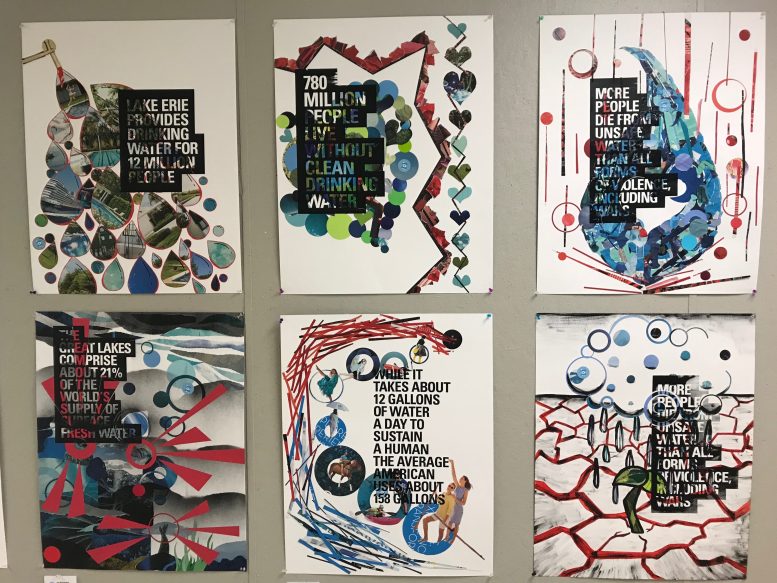By DAVID DUPONT
BG Independent News
Taking care of the water of Lake Erie starts by taking care of the land.
Earlier this month, a panel convened at Bowling Green State University to discuss The Future of Lake Erie. The panel was the final event in a semester-long concentration on the lake that was centered on “Water in Crisis,” a pair of photography exhibits in the School of Art galleries.
“If we heal our watershed, we’ll heal our lake,” said Tim Davis, a bioscientist who studies harmful algae blooms.
Davis’ colleague on the BGSU geochemist Angelica Vasquez-Ortega said best practices have been identified. The problem is how to keep the nutrients, particularly nitrogen and phosphorus applied to farm fields, from running off into the lake where they foster the growth of algae.
Vasquez-Ortega said that cover crops, plants grown over the winter, both reduce the amount of nutrients running from the fields, but also reduce the amount farmers need to apply since they supply nutrients needed for other crops to grow.
That’s a cost savings for them in the long run.
But cover crops are not widely used, she said.
That problem is the cost.
“How do you clean up the lake? You have healthy soils so you hold onto the nutrients, so you’re not flushing them down into the lake,” said Bob Jones, who operates Chef’s Garden, a 400-acre vegetable farm in Huron, “The programs we’re using now are not working because they’re a quick fix.”
Farmers can get government money to plant wheat as a cover crop, but only for one year. The farmer is not eligible the next year, and most cannot afford to plant.

He recalled asking an official from the Natural Resources Conservation Service whether the programs now in place are working. The official didn’t answer the question, Jones said. “So I got my answer.”
He continued: “Agricultural has the highest suicide rates of any profession because we’ve created a model that’s not sustainable.”
Local farmer Paul Herringshaw, who was in the audience with his son Brian, weighed in.
Herringshaw said he plants wheat, and that helps increase yields on his soy and corn crop. But it’s not simple. There’s not a lot of time to get that wheat crop in after the corn and soy are harvested, and the benefits don’t show up for three years.
Many farmers cannot make that investment.
Government incentives would help, he said.
Jones advocates bringing back price supports for wheat.
Price supports involve the government setting a floor on the price of a commodity. If the market price is lower, then the government purchases at the set price.
Jones noted his operation is different from those who grow corn, soy, and wheat. He plants only 125 acres a year, letting the rest remain fallow. The result is much higher yields when those fields are used.
Others, he said, don’t have that luxury.
Those crops though could help meet the challenges posed by climate change.
Healthier soil, Jones said, will hold the water better and then the moisture will be available later in the summer when dry weather sets. Now plants have very shallow roots during the rainy season, which make it difficult for them to thrive in dry times.
More resilient soil, Vasquez-Ortega said, “will have perfect characteristics to function … under those extremes.”
Precipitation patterns are changing, Davis said. The heavy rain this spring meant many farmers couldn’t plant.
Data collected showed that the runoff was very heavy, but contained 30 percent less phosphorus than would be expected for that volume of water.
He said that climate change also will alter the timing and extent of harmful algae blooms.
“We’re seeing the bloom initiate earlier and end later,” he said.
The runoff in spring delivers the nutrients to the western basin of Lake Erie, then the water must warm up enough so the algae can bloom. That’s happening earlier, and the lake is staying warmer longer so the algae doesn’t go away until early fall.
From 2002, when the harmful algae bloom started being monitored, until 2017, the length of time the lake can support the bloom has increased two weeks, and he expects it will continue to increase somewhat more.
Questions persist about the causes though studies show that just over 80 percent of the nutrient loading comes from agricultural sources.
Linda Butler, whose photographs of Lake Erie and its surroundings were on exhibit on campus, said she was not as concerned with crop farmers as with the run-off from concentrated animal feeding operations.
Brian Herringshaw brought up a hypothesis that the Clean Air Act, by taking sulphur out of the air changed the chemistry in the water that made more phosphorus available.
Tom Henry, an environmental reporter for the Toledo Blade, said he recalls a time when those in the fishing industry were concerned that the lake had become too clear, and was hindering the fish populations.
The veteran journalist recalled that when he wrote a story about the early signs of the algae bloom in the lake in 1995, the article was mocked by radio “shock jocks” who referred to the algae bloom as “green monster.”
Henry also said he’s visited a mountain lake in Colorado that had harmful algae.
Algae had been a problem In Lake Erie before, and changes in the handling of waste water and the removal phosphorus from consumer products solved the problem, until it re-emerged.
Davis cautioned against equating the problems.
“The blooms are fundamentally different for those in the fifties and sixties,” he said. “They’re different organisms.”
That algae could produce its own nitrogen, so it only needed phosphorus, and the source of that was factories and urban water systems. Now the blooms need the nitrogen as well.
He said scientists are still trying to figure out all the mechanisms.
But the public should not think of the lake as simply broken or fixed. People thought it was fixed in the 1980s, “and we took our eye off the ball,” Davis said.
Other concerns, such as invasive species, got the attention. “We stopped monitoring,” he said, and then when the bloom re-emerged “it caught us off guard.”
The panelists had a variety of answers for what needs to be done to address the issue.
Marya Czech, from Freshwater Future, said cities and individuals need to rethink the concept of lawns as green spaces, given the chemicals needed to maintain them.
Vote for politicians who care about water quality, said Alexis Smith, an activist with Freshwater Future.
Louise Stevenson, BGSU biology professor who studies pollutants, said politicians and the public need to engage scientists to develop pro-active responses.
She’s concerned by “the systematic exclusion of scientists from policies and the way policies are dismantled and scientists are being excluded.”





